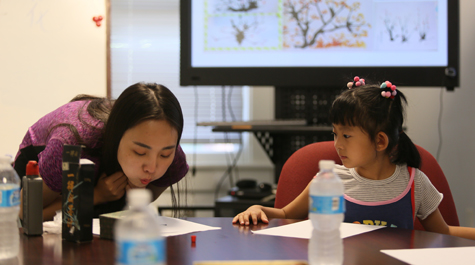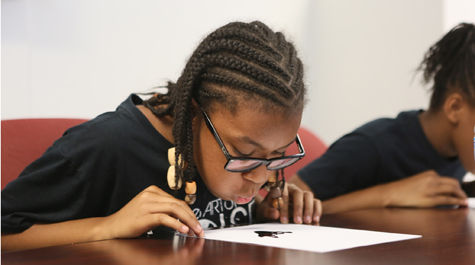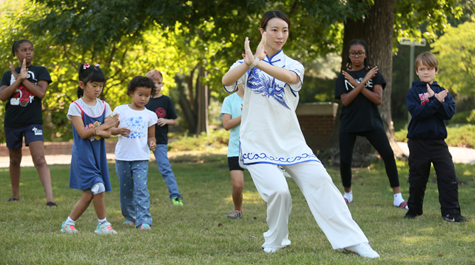Gaining a deeper feeling for Chinese culture
Exhaling so gently that it might not cause the flame of a candle to flicker, Xiaolu Ma sent a drop of black ink on a brief journey to the edge of a white sheet of paper.
As the ink moved down the page, settling into the shape of a tree, the eyes of a group of children attending the Chinese Culture Summer Camp at the William & Mary Confucius Institute last week brightened and widened.
Ma, a graduate student at Beijing Normal University who is serving an internship at the Confucius Institute, was teaching the art of creating a plum tree, or Mei Hua in Chinese.
{{youtube:medium|YI0FFsV7-bc, The Mei Hua}}
The Confucius Institute began offering camps in Chinese culture during the spring and summer in 2013, said Ying Liu, the institute’s associate director.
“It’s very popular with children, and we limit the number to eight,” she said. “We don’t have a large space, and we want to try and make it fun and interactive. We think that’s a good way to get them interested in our culture.”
Over the course of five two-hour days, the students were exposed to Chinese brush painting, Chinese games, Chinese martial arts, Chinese musical instruments, Chinese paper cutting and Chinese calligraphy.
After Ma’s demonstration with the ink and paper, she went around the conference room at Rowe House and pumped a drop of ink on the paper in front of her students.
Phew ... phew ... phew …
The children blew on their pages, spreading the ink in similar fashion to Ma.
Ma then pulled out what looked like a ceramic candy dish with a lid. Inside was red ink. She gave the children a piece of shaped plastic that fit over their index finger, then showed them that the ink was intended to draw blossoms on the tree. Then she brought out crayons to fill in grass, sky and any other elements the children desired.
For the next 45 minutes, the children and three tutors enjoyed themselves.
Sitting off to the side, taking it all in, was Isabelle Szczerbinski, a 12-year-old homeschooler from Richmond. Having attended the camp previously, Szczerbinski was serving as an assistant counselor, a helping hand when needed.
She has been passionate about Chinese culture since the time as a child she attempted to speak with a Chinese chef at a Dallas restaurant, but couldn’t because he didn’t speak English.
“She came back to the table,” said her father, Eric Szczerbinski, “and said she would have liked to talk to the man, and would it be possible for her to learn Chinese.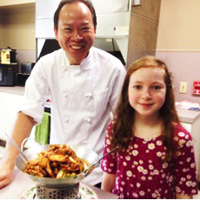
“We think it’s very important for kids to learn multiple languages. In most other parts of the world, it’s just standard. In Europe, about 80 percent of kids have exposure, not just to two but three languages in grade school. In America, it’s about 18 percent. So there’s a huge difference.”
His daughter is now fluent in a conversational dialect of Chinese.
“Most of the world speaks a different language, and you can’t communicate with the rest of the world to get your ideas across if you just speak English,” she said. “You’d need a translator or someone who actually speaks the other languages. I feel like everyone needs to be their own translator so that they can understand the nuances of the language.”
Isabelle Szczerbinski said what stands out for her about Chinese culture is its extraordinary longevity.
“I like how it’s still the same, or very similar, after 5,000 years,” she said. “We still have stories about people who lived more than 5,000 years ago through folk stories, and I find that very cool.”
{{youtube:medium|NDPYd8DDBJI, Chinese martial arts}}
Szczerbinski watched earlier in the day when Lianghao Liu, another intern and graduate student from Beijing Normal, guided the class to Barksdale Field. On the agenda was an introduction to Chinese martial arts, which Liu has been studying since high school.
Liu painstakingly reviewed the basics of warming up and the most elementary aspects of the discipline.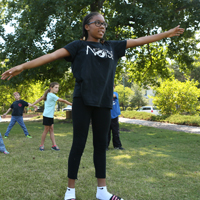
That was one of the highlights of the day for Aliyah Battle, 13, of Richmond, who said she wanted to attend the Chinese Culture Summer Camp “because you should always try something different.”
Battle did exactly that a couple of years ago, downloading a Chinese language app onto her cellphone “just to see if I could learn the language.”
“But it didn’t help,” she admitted good-naturedly. “It was very difficult. Still, it’s good to try a different language.”















